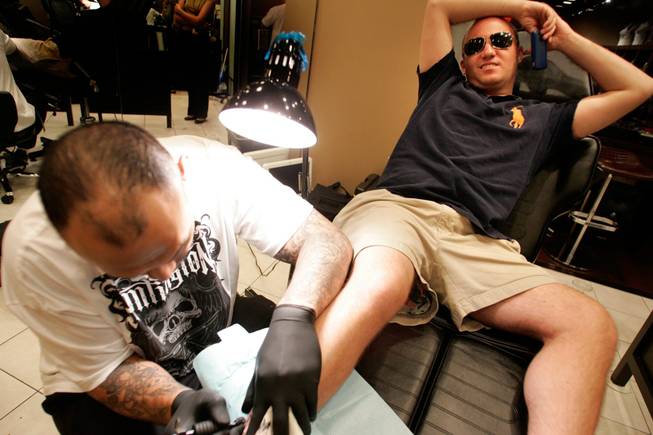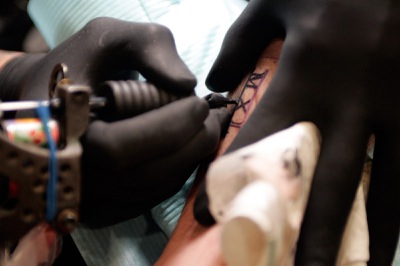
No pain, no gain: Bill Duffey of Boston receives a tattoo from Eric “Big E” Pele at Huntington Ink inside the Palms on July 10. Tattoos average $200 at the shop, which opened in May.
Friday, July 17, 2009 | 3 a.m.
Farley-Saavedra Interview
The growing acceptance of body art does not mean more businesses accept their workers "inked up." What is a company to do with tattoos? In Business talks with HR Business Partners President Patricia Farley-Saavedra.
Sun Coverage
Toodeloo, tattoo taboo.
It’s those crazy kids, don’t ya know, with their crayon-inspired hair, metal-pierced faces and tattoos, well, everywhere, that can give employers nightmares. Not so much the chance of having an employee with an affinity for body art — they probably do — but how to enforce a dress code appropriate for the business.
But it’s not only the kids adorning themselves with body art that would have elicited stares just a couple of years ago.
It’s everyone.
“The whole stigma of tattooing has changed,” said John Huntington, owner of Huntington Ink, a tattoo parlor inside the Palms. “It’s so mainstream, it’s unbelievable. Tattoos are no longer the sailor (and) prison thing. It’s kind of like an extension of jewelry.”
A 2008 Harris Interactive Poll found 32 percent of people in their late 20s have tattoos — the age group with the most tattoos. One-fourth of people in their 30s reported having tattoos, and 12 percent of people in their 40s have at least one.
Those 18 to 24 were similar to those 65 and older, with 9 percent having tattoos. Those 50 to 64 had the fewest, with just 8 percent reporting tattoos.
One-fifth of people living in the West reported having tattoos, the region with the highest rate.
Because displaying body art in the workplace isn’t constitutionally protected, most companies have policies that prohibit visible tattoos and body piercings, said Arte Nathan, president of Strategic Development Worldwide, a San Diego-based management consulting firm.
“Tattooing in society is changing,” he said. “People you never thought would be a candidate have a tattoo.”
In the past, many companies forbade visible tattoos because of the stigma attached, such as bikers’ love of ink.
Employers should avoid policies that allow “tasteful” tattoos, not only because taste is subjective, but if an employee is singled out and told he must cover his tattoo, it becomes a freedom of speech issue.
“It’s all or nothing,” Nathan said. “It’s far easier to ban than to regulate.”
That way, if an employee or job candidate accuses the boss of discrimination, it is easier to defend.
Typically in the United States, people don’t wear body art for cultural reasons with a few exceptions, such as some American Indians.
“It’s more of a fad for young people,” he said.
When interviewing a job candidate who has tattoos on the lower arms or facial piercings, Nathan said to give the candidate the company’s body art policy and offer him the option to wear long sleeves or remove the piercings while on the job.
“Are you willing to wear long sleeves?” he suggests asking potential hires.
But these days, customers are less threatened or discomforted by body art and more concerned about the service they receive.
But as tattoos migrate from the lower arm to the hands and knuckles, or from the shoulder to the neck, face or shaved head, regulation becomes more complicated.
People with body art not easily covered who are entering the corporate world may want to consider the latest trend among tattoo shop owners — removal of the most conspicuous tattoos.
“They can’t hope for anything,” Nathan said. “An employer doesn’t have to hire anyone. He can choose not to hire. It’s not a discriminatory act.”
Huntington picked up on the demand for tattoo removal and is opening a shop catering to those customers, he said. Huntington Ink opened May 1 and is planning a tattoo removal business.
But people still want tattoos.
“It’s leaps and bounds over what it was even five years ago,” he said. “It’s gaining more and more power.”
Huntington credited TV reality shows such as “Inked,” a show that featured Hart & Huntington, a parlor he ran with former business partner Carey Hart at the Palms.
Huntington said he talked Palms owner George Maloof into allowing the casino’s bellboys and valets to display tattoos on the job.
“That’s how mainstream it is now,” he said. “The gamut is no longer the rock ’n’ roller, the rockabilly, the thug. It is my mom and dad, it is anybody. There is no longer a demographic for tattoos. I see everybody coming into my shop.”
Tattoos average $200 at his shop, the minimum about $100, he said. On a typical Friday or Saturday, his artists will tattoo about 45 people.
Huntington’s business is doing so well he is rolling out new locations over the next year: San Diego; Dallas; Austin, Texas; New York; Miami; and Bangkok.
How does a businessperson end up with a tattoo?
Huntington said the scenario he sees is the businessperson is out with friends, having a crazy-fun night, and what comes to mind? A tattoo, of course.
When Nathan was a human resources boss for Mirage Resorts and Wynn Resorts, he said the policy was across-the-board strict.
“No visible tattoos or body piercings, period. It’s a simple statement and easily enforced.”
Twenty-nine percent of employers are strongly influenced by a prospective employee’s obvious tattoos, according to a 2006 survey by the National Association of Colleges and Employers.
A larger portion — 46 percent — said it would only slightly influence their hiring decision, and the rest — 25 percent — said visible tattoos wouldn’t influence their decision at all.
Employers were more strongly influenced by a candidate’s grooming (73 percent) and whether they wore nontraditional interviewing attire (49 percent).
Bill Duffey has two tattoos, the most recent one acquired during a Las Vegas visit. He said both are in places not visible when wearing work attire.
“I would never have a tattoo that is visible,” he said, adding he is “judgmental” of people who have visible tattoos.
Duffey recently took over the family’s commercial printing business near Boston, an area he describes as “preppy and highbrow.”
“What’s their history, what’s their past?” he wonders when interviewing someone with visible tattoos, he said. “I wouldn’t hire them if I could see (the tattoos).”
That could be the sentiment some tattoo seekers have as they pick a flash (a tattoo shop’s pre-made art) from a shop’s portfolio.
Tattoo artist Eric “Big E” Pele said he’s seen a change in the demographics sitting in his tattoo chair — more conservative people as well as senior citizens.
“They want to express themselves, but they want to keep it hidden,” he said.



Join the Discussion:
Check this out for a full explanation of our conversion to the LiveFyre commenting system and instructions on how to sign up for an account.
Full comments policy